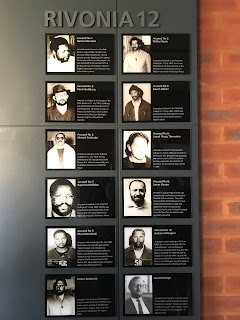South Africa - Day 5
Today we visited Liliesleaf, a safe house and planning spot for the resistance movement, and the location of a police raid that set in motion the Ravonia Trial which indicted Nelson Mandela and others to life in prison. After our prior days consuming primary sources in museums and though first person narratives, my background knowledge felt solid, so today's lecture of important people and events finally felt as though the dots were connecting in my head.
Goals update:
Goal 1: Connecting with Peers from the Program, and in the Field
During today's bus ride and afternoon stretch break, I connected with two middle school educators that I hadn't talked to yet. On our introductory weekend together in DC last October, the NEA Foundation shared with us the emerging Empatico as a tool for interacting with students from around the globe. It was mostly geared towards the elementary grades, so I didn't pursue using this with students. After today's conversations, with two different teachers who had positive experiences with their 6th graders, I plan to sign up for this upcoming school year.
Goal 2: Finding South African Art to Share with Students
This sculpture at the entrance of Liliesleaf was eye catching. The blank steel rectangles were made to look like books, to show that everyone, known or anonymous, has their apartheid resistance story. Our 8th graders study memorials and monuments, and this is a great piece to include.
Goal 3: Making Personal Art Daily
In the afternoon I sketched the guest speakers who gave both a micro and macro look at education in the country. University of Johannesburg maths education professor Nicky Roberts shared that math was not even offered in black Bantu schools during apartheid, and alarmingly that social workers are few in today's schools, despite the high trauma and need of students. Principal of Impala Crescent Primary, Naazim Adam shared why he chooses to stay and work in schools, "Use your power to influence your space." After an hour of explaining challenges the country is facing (many of which are the same as in the US), we ended on things that are going well. Black teachers are now paid at the same rates as white. All South African students now have access to transportation to get to school, and students in need are fed in school, a step in the right direction for achieving UN Sustainable Development Goal #4: Inclusive and Equitable Access to a Quality Education and Goal #2: Zero Hunger. Mr. Adam concluded, "We have been wounded, but we have become strong."
Goals update:
Goal 1: Connecting with Peers from the Program, and in the Field
During today's bus ride and afternoon stretch break, I connected with two middle school educators that I hadn't talked to yet. On our introductory weekend together in DC last October, the NEA Foundation shared with us the emerging Empatico as a tool for interacting with students from around the globe. It was mostly geared towards the elementary grades, so I didn't pursue using this with students. After today's conversations, with two different teachers who had positive experiences with their 6th graders, I plan to sign up for this upcoming school year.
Goal 2: Finding South African Art to Share with Students
Goal 3: Making Personal Art Daily
In the afternoon I sketched the guest speakers who gave both a micro and macro look at education in the country. University of Johannesburg maths education professor Nicky Roberts shared that math was not even offered in black Bantu schools during apartheid, and alarmingly that social workers are few in today's schools, despite the high trauma and need of students. Principal of Impala Crescent Primary, Naazim Adam shared why he chooses to stay and work in schools, "Use your power to influence your space." After an hour of explaining challenges the country is facing (many of which are the same as in the US), we ended on things that are going well. Black teachers are now paid at the same rates as white. All South African students now have access to transportation to get to school, and students in need are fed in school, a step in the right direction for achieving UN Sustainable Development Goal #4: Inclusive and Equitable Access to a Quality Education and Goal #2: Zero Hunger. Mr. Adam concluded, "We have been wounded, but we have become strong."





Comments
Post a Comment